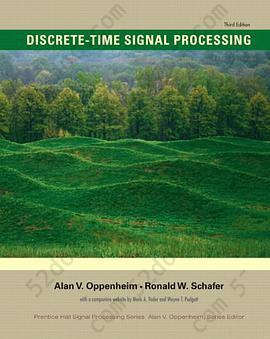注重体验与质量的电子书资源下载网站
分类于: 互联网 职场办公
简介

Discrete-Time Signal Processing 豆 9.2分
资源最后更新于 2020-09-17 15:00:49
作者:Alan V. Oppenheim
出版社:Pearson
出版日期:2009-01
ISBN:9780131988422
文件格式: pdf
标签: DSP 通信理论 电子 教材 信号与系统 textbook 数字信号处理 通信原理
简介· · · · · ·
For senior/graduate-level courses in Discrete-Time Signal Processing. THE definitive, authoritative text on DSP -- ideal for those with an introductory-level knowledge of signals and systems. Written by prominent, DSP pioneers, it provides thorough treatment of the fundamental theorems and properties of discrete-time linear systems, filtering, sampling, and discrete-time Fourie...
目录
Preface
The Companion Website
The Cover
Acknowledgments
1 Introduction
2 Discrete-Time Signals and Systems
2.0 Introduction
2.1 Discrete-Time Signals
2.2 Discrete-Time Systems
2.3 LTI Systems
2.4 Properties of Linear Time-Invariant Systems
2.5 Linear Constant-Coefficient Difference Equations
2.6 Frequency-Domain Representation of Discrete-Time Signals and Systems
2.7 Representation of Sequences by Fourier Transforms
2.8 Symmetry Properties of the Fourier Transform
2.9 Fourier Transform Theorems
2.10 Discrete-Time Random Signals
2.11 Summary
3 The z-Transform
3.0 Introduction
3.1 z-Transform
3.2 Properties of the ROC for the z-Transform
3.3 The Inverse z-Transform
3.4 z-Transform Properties
3.5 z-Transforms and LTI Systems
3.6 The Unilateral z-Transform
3.7 Summary
4 Sampling of Continuous-Time Signals
4.0 Introduction
4.1 Periodic Sampling
4.2 Frequency-Domain Representation of Sampling
4.3 Reconstruction of a Bandlimited Signal from Its Samples
4.4 Discrete-Time Processing of Continuous-Time Signals
4.5 Continuous-Time Processing of Discrete-Time Signals
4.6 Changing the Sampling Rate Using Discrete-Time Processing
4.7 Multirate Signal Processing
4.8 Digital Processing of Analog Signals
4.9 Oversampling and Noise Shaping in A/D and D/A Conversion
4.10 Summary
5 Transform Analysis of Linear Time-Invariant Systems
5.0 Introduction
5.1 The Frequency Response of LTI Systems
5.2 System Functions—Linear Constant-Coefficient Difference Equations
5.3 Frequency Response for Rational System Functions
5.4 Relationship between Magnitude and Phase
5.5 All-Pass Systems
5.6 Minimum-Phase Systems
5.7 Linear Systems with Generalized Linear Phase
5.8 Summary
6 Structures for Discrete-Time Systems
6.0 Introduction
6.1 Block Diagram Representation of Linear Constant-Coefficient Difference Equations
6.2 Signal Flow Graph Representation
6.3 Basic Structures for IIR Systems
6.4 Transposed Forms
6.5 Basic Network Structures for FIR Systems
6.6 Lattice Filters
6.7 Overview of Finite-Precision Numerical Effects
6.8 The Effects of Coefficient Quantization
6.9 Effects of Round-off Noise in Digital Filters
6.10 Zero-Input Limit Cycles in Fixed-Point Realizations of IIR Digital Filters
6.11 Summary
7 Filter Design Techniques
7.0 Introduction
7.1 Filter Specifications
7.2 Design of Discrete-Time IIR Filters from Continuous-Time Filters
7.3 Discrete-Time Butterworth, Chebyshev and Elliptic Filters
7.4 Frequency Transformations of Lowpass IIR Filters
7.5 Design of FIR Filters by Windowing
7.6 Examples of FIR Filter Design by the KaiserWindow Method
7.7 Optimum Approximations of FIR Filters
7.8 Examples of FIR Equiripple Approximation
7.9 Comments on IIR and FIR Discrete-Time Filters
7.10 Design of an Upsampling Filter
7.11 Summary
8 The Discrete Fourier Transform
8.0 Introduction
8.1 Representation of Periodic Sequences: The Discrete Fourier Series
8.2 Properties of the DFS
8.3 The Fourier Transform of Periodic Signals
8.4 Sampling the Fourier Transform
8.5 Fourier Representation of Finite-Duration Sequences
8.6 Properties of the DFT
8.7 Linear Convolution Using the DFT
8.8 The Discrete Cosine Transform (DCT)
8.9 Summary
9 Computation of the Discrete Fourier Transform
9.0 Introduction
9.1 Direct Computation of the Discrete Fourier Transform
9.2 Decimation-in-Time FFT Algorithms
9.3 Decimation-in-Frequency FFT Algorithms
9.4 Practical Considerations
9.5 More General FFT Algorithms
9.6 Implementation of the DFT Using Convolution
9.7 Effects of Finite Register Length
9.8 Summary
10 Fourier Analysis of Signals Using the Discrete Fourier Transform
10.0 Introduction
10.1 Fourier Analysis of Signals Using the DFT
10.2 DFT Analysis of Sinusoidal Signals
10.3 The Time-Dependent Fourier Transform
10.4 Examples of Fourier Analysis of Nonstationary Signals
10.5 Fourier Analysis of Stationary Random Signals: the Periodogram
10.6 Spectrum Analysis of Random Signals
10.7 Summary
11 Parametric Signal Modeling
11.0 Introduction
11.1 All-Pole Modeling of Signals
11.2 Deterministic and Random Signal Models
11.3 Estimation of the Correlation Functions
11.4 Model Order
11.5 All-Pole Spectrum Analysis
11.6 Solution of the Autocorrelation Normal Equations
11.7 Lattice Filters
11.8 Summary
12 Discrete Hilbert Transforms
12.0 Introduction
12.1 Real- and Imaginary-Part Sufficiency of the Fourier Transform
12.2 Sufficiency Theorems for Finite-Length Sequences
12.3 Relationships Between Magnitude and Phase
12.4 Hilbert Transform Relations for Complex Sequences
12.5 Summary
13 Cepstrum Analysis and Homomorphic Deconvolution
13.0 Introduction
13.1 Definition of the Cepstrum
13.2 Definition of the Complex Cepstrum
13.3 Properties of the Complex Logarithm
13.4 Alternative Expressions for the Complex Cepstrum
13.5 Properties of the Complex Cepstrum
13.6 Computation of the Complex Cepstrum
13.7 Computation of the Complex Cepstrum Using Polynomial Roots
13.8 Deconvolution Using the Complex Cepstrum
13.9 The Complex Cepstrum for a Simple Multipath Model
13.10 Applications to Speech Processing
13.11 Summary
A Random Signals
B Continuous-Time Filters
C Answers to Selected Basic
Bibliography
Index
The Companion Website
The Cover
Acknowledgments
1 Introduction
2 Discrete-Time Signals and Systems
2.0 Introduction
2.1 Discrete-Time Signals
2.2 Discrete-Time Systems
2.3 LTI Systems
2.4 Properties of Linear Time-Invariant Systems
2.5 Linear Constant-Coefficient Difference Equations
2.6 Frequency-Domain Representation of Discrete-Time Signals and Systems
2.7 Representation of Sequences by Fourier Transforms
2.8 Symmetry Properties of the Fourier Transform
2.9 Fourier Transform Theorems
2.10 Discrete-Time Random Signals
2.11 Summary
3 The z-Transform
3.0 Introduction
3.1 z-Transform
3.2 Properties of the ROC for the z-Transform
3.3 The Inverse z-Transform
3.4 z-Transform Properties
3.5 z-Transforms and LTI Systems
3.6 The Unilateral z-Transform
3.7 Summary
4 Sampling of Continuous-Time Signals
4.0 Introduction
4.1 Periodic Sampling
4.2 Frequency-Domain Representation of Sampling
4.3 Reconstruction of a Bandlimited Signal from Its Samples
4.4 Discrete-Time Processing of Continuous-Time Signals
4.5 Continuous-Time Processing of Discrete-Time Signals
4.6 Changing the Sampling Rate Using Discrete-Time Processing
4.7 Multirate Signal Processing
4.8 Digital Processing of Analog Signals
4.9 Oversampling and Noise Shaping in A/D and D/A Conversion
4.10 Summary
5 Transform Analysis of Linear Time-Invariant Systems
5.0 Introduction
5.1 The Frequency Response of LTI Systems
5.2 System Functions—Linear Constant-Coefficient Difference Equations
5.3 Frequency Response for Rational System Functions
5.4 Relationship between Magnitude and Phase
5.5 All-Pass Systems
5.6 Minimum-Phase Systems
5.7 Linear Systems with Generalized Linear Phase
5.8 Summary
6 Structures for Discrete-Time Systems
6.0 Introduction
6.1 Block Diagram Representation of Linear Constant-Coefficient Difference Equations
6.2 Signal Flow Graph Representation
6.3 Basic Structures for IIR Systems
6.4 Transposed Forms
6.5 Basic Network Structures for FIR Systems
6.6 Lattice Filters
6.7 Overview of Finite-Precision Numerical Effects
6.8 The Effects of Coefficient Quantization
6.9 Effects of Round-off Noise in Digital Filters
6.10 Zero-Input Limit Cycles in Fixed-Point Realizations of IIR Digital Filters
6.11 Summary
7 Filter Design Techniques
7.0 Introduction
7.1 Filter Specifications
7.2 Design of Discrete-Time IIR Filters from Continuous-Time Filters
7.3 Discrete-Time Butterworth, Chebyshev and Elliptic Filters
7.4 Frequency Transformations of Lowpass IIR Filters
7.5 Design of FIR Filters by Windowing
7.6 Examples of FIR Filter Design by the KaiserWindow Method
7.7 Optimum Approximations of FIR Filters
7.8 Examples of FIR Equiripple Approximation
7.9 Comments on IIR and FIR Discrete-Time Filters
7.10 Design of an Upsampling Filter
7.11 Summary
8 The Discrete Fourier Transform
8.0 Introduction
8.1 Representation of Periodic Sequences: The Discrete Fourier Series
8.2 Properties of the DFS
8.3 The Fourier Transform of Periodic Signals
8.4 Sampling the Fourier Transform
8.5 Fourier Representation of Finite-Duration Sequences
8.6 Properties of the DFT
8.7 Linear Convolution Using the DFT
8.8 The Discrete Cosine Transform (DCT)
8.9 Summary
9 Computation of the Discrete Fourier Transform
9.0 Introduction
9.1 Direct Computation of the Discrete Fourier Transform
9.2 Decimation-in-Time FFT Algorithms
9.3 Decimation-in-Frequency FFT Algorithms
9.4 Practical Considerations
9.5 More General FFT Algorithms
9.6 Implementation of the DFT Using Convolution
9.7 Effects of Finite Register Length
9.8 Summary
10 Fourier Analysis of Signals Using the Discrete Fourier Transform
10.0 Introduction
10.1 Fourier Analysis of Signals Using the DFT
10.2 DFT Analysis of Sinusoidal Signals
10.3 The Time-Dependent Fourier Transform
10.4 Examples of Fourier Analysis of Nonstationary Signals
10.5 Fourier Analysis of Stationary Random Signals: the Periodogram
10.6 Spectrum Analysis of Random Signals
10.7 Summary
11 Parametric Signal Modeling
11.0 Introduction
11.1 All-Pole Modeling of Signals
11.2 Deterministic and Random Signal Models
11.3 Estimation of the Correlation Functions
11.4 Model Order
11.5 All-Pole Spectrum Analysis
11.6 Solution of the Autocorrelation Normal Equations
11.7 Lattice Filters
11.8 Summary
12 Discrete Hilbert Transforms
12.0 Introduction
12.1 Real- and Imaginary-Part Sufficiency of the Fourier Transform
12.2 Sufficiency Theorems for Finite-Length Sequences
12.3 Relationships Between Magnitude and Phase
12.4 Hilbert Transform Relations for Complex Sequences
12.5 Summary
13 Cepstrum Analysis and Homomorphic Deconvolution
13.0 Introduction
13.1 Definition of the Cepstrum
13.2 Definition of the Complex Cepstrum
13.3 Properties of the Complex Logarithm
13.4 Alternative Expressions for the Complex Cepstrum
13.5 Properties of the Complex Cepstrum
13.6 Computation of the Complex Cepstrum
13.7 Computation of the Complex Cepstrum Using Polynomial Roots
13.8 Deconvolution Using the Complex Cepstrum
13.9 The Complex Cepstrum for a Simple Multipath Model
13.10 Applications to Speech Processing
13.11 Summary
A Random Signals
B Continuous-Time Filters
C Answers to Selected Basic
Bibliography
Index








